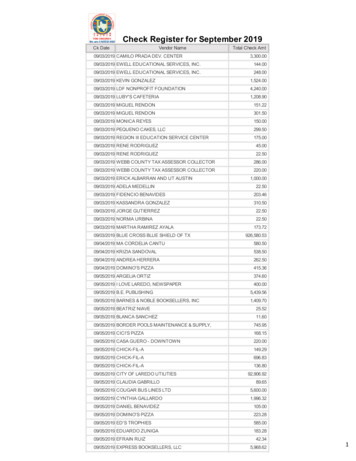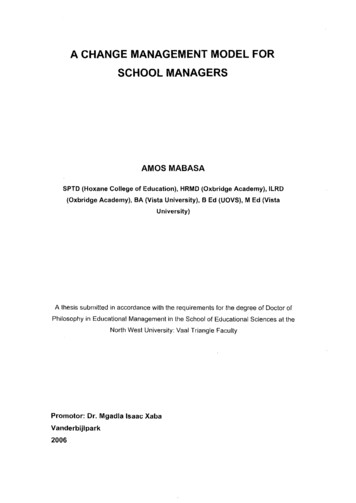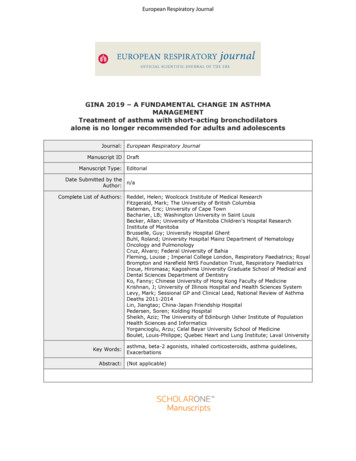
Transcription
European Respiratory JournalGINA 2019 – A FUNDAMENTAL CHANGE IN ASTHMAMANAGEMENTTreatment of asthma with short-acting bronchodilatorsalone is no longer recommended for adults and adolescentsJournal: European Respiratory JournalManuscript ID DraftManuscript Type: EditorialDate Submitted by then/aAuthor:Complete List of Authors: Reddel, Helen; Woolcock Institute of Medical ResearchFitzgerald, Mark; The University of British ColumbiaBateman, Eric; University of Cape TownBacharier, LB; Washington University in Saint LouisBecker, Allan; University of Manitoba Children's Hospital ResearchInstitute of ManitobaBrusselle, Guy; University Hospital GhentBuhl, Roland; University Hospital Mainz Department of HematologyOncology and PulmonologyCruz, Alvaro; Federal University of BahiaFleming, Louise ; Imperial College London, Respiratory Paediatrics; RoyalBrompton and Harefield NHS Foundation Trust, Respiratory PaediatricsInoue, Hiromasa; Kagoshima University Graduate School of Medical andDental Sciences Department of DentistryKo, Fanny; Chinese University of Hong Kong Faculty of MedicineKrishnan, J; University of Illinois Hospital and Health Sciences SystemLevy, Mark; Sessional GP and Clinical Lead, National Review of AsthmaDeaths 2011-2014Lin, Jiangtao; China-Japan Friendship HospitalPedersen, Soren; Kolding HospitalSheikh, Aziz; The University of Edinburgh Usher Institute of PopulationHealth Sciences and InformaticsYorgancioglu, Arzu; Celal Bayar University School of MedicineBoulet, Louis-Philippe; Quebec Heart and Lung Institute; Laval UniversityKey Words:asthma, beta-2 agonists, inhaled corticosteroids, asthma guidelines,ExacerbationsAbstract: (Not applicable)
Page 1 of 4555657585960European Respiratory Journal
European Respiratory 525354555657585960Page 2 of 27GINA 2019 – A FUNDAMENTAL CHANGE IN ASTHMA MANAGEMENTTreatment of asthma with short-acting bronchodilators alone is no longer recommended foradults and adolescentsHelen K Reddel1, J Mark FitzGerald2, Eric D Bateman3, Leonard Bacharier4, Allan Becker5, GuyBrusselle6, Roland Buhl7, Alvaro A Cruz8, Louise Fleming9, Hiromasa Inoue10, Fanny Wai-san Ko11,Jerry Krishnan12, Mark L Levy13, Jiangtao Lin14, Søren E Pedersen15, Aziz Sheikh16, ArzuYorgancioglu17, Louis-Philippe Boulet181. Woolcock Institute of Medical Research, University of Sydney, NSW, Australia, and Chair of theGINA Science Committee2. Respiratory Division, Faculty of Medicine, University of British Columbia, Vancouver, BC,Canada3. Division of Pulmonology & Department of Medicine, University of Cape Town and University ofCape Town Lung Institute, Cape Town, South Africa4. Washington University and St. Louis Children’s Hospital, St Louis, MO, USA5. Section of Allergy and Clinical Immunology, Children's Hospital Research Institute of Manitoba,University of Manitoba, Canada6. Ghent University Hospital, Ghent, Belgium7. Pulmonary Department, Mainz University Hospital, Mainz, Germany8. ProAR Foundation and Federal University of Bahia, Brazil9. Department of Respiratory Paediatrics, Royal Brompton Hospital, London, United Kingdom10. Department of Pulmonary Medicine, Graduate School of Medical and Dental Sciences,Kagoshima University, Kagoshima, Japan11. Department of Medicine and Therapeutics, The Chinese University of Hong Kong, Hong Kong12. Breathe Chicago Center, University of Illinois at Chicago, Chicago, IL, USA13. Sessional GP and Clinical Lead National Review of Asthma Deaths, United Kingdom, andChair of the GINA Dissemination and Implementation Committee1
Page 3 of 4555657585960European Respiratory Journal14. China-Japan Friendship Hospital, Peking University, Beijing, China15. Kolding Hospital, Kolding, Denmark16. Usher Institute of Population Health Sciences and Informatics, The University of Edinburgh,Edinburgh, United Kingdom17. Celal Bayar University, Medical Faculty, Department of Pulmonology, Manisa, Turkey18. Québec Heart and Lung Institute, Laval University, Québec City, Canada, and Chair of theGINA BoardCorresponding author:Professor Helen Reddel, Woolcock Institute of Medical Research, The University of Sydney, NSW,AustraliaPhone: 61 2 9114 0437Fax: 61 2 9114 0011Email: helen.reddel@sydney.edu.auKeywords: asthma, beta2-agonists, inhaled corticosteroids, asthma guidelines, exacerbationsWord count: 20632
European Respiratory 525354555657585960Page 4 of 27In April 2019, the Global Initiative for Asthma (GINA, see Box) published new recommendationsthat might be considered the most fundamental change in asthma management in 30 years. Thenew recommendations follow a decade-long programme of work by GINA, prompted by concernsabout the risks and consequences of the long-standing approach of commencing asthma treatmentwith short-acting beta2-agonists (SABA) alone. These initiatives were aimed at obtaining evidenceabout effective treatment options for mild asthma and providing consistent messaging for patientsand clinicians across the spectrum of asthma severity. For safety, GINA no longer recommendstreatment of asthma in adolescents and adults with SABA alone. Instead, to reduce theirrisk of serious exacerbations, all adults and adolescents with asthma should receive eithersymptom-driven (in mild asthma) or daily inhaled corticosteroid (ICS)-containing treatment.Here, we provide the background to these recommendations, summarise the evidence andrationale for the changes, and identify research gaps.The risks of SABA were the focus of extensive research in the 1980s and 1990s following twointernational epidemics of asthma deaths,[1] with case-control studies showing that over-use ofSABA was associated with increased risk of asthma-related death.[2, 3] Randomised controlledtrials (RCTs) found no advantage in regular versus as-needed SABA,[4, 5] and by the late 1990s,most guidelines recommended as-needed rather than regular SABA. In parallel, extensiveevidence emerged of the protective value of regular ICS, with a dramatic reduction in the risk ofasthma-related hospitalisations and death.[6, 7] Large RCTs demonstrated that in mild asthma, lowdose ICS reduced severe exacerbations by 50%, as well as controlling symptoms and improvingquality of life.[8, 9] However, acceptance of daily ICS was slow, partly based on physician concernabout the serious side-effects seen with oral corticosteroids.[1] Concern about b2-agonist risks inasthma largely shifted to long-acting b2-agonists (LABA), with recommendations against LABAonly treatment, but in guidelines, SABA-only treatment remained unchallenged as the initialtherapy for mild asthma, with ICS use recommended only for patients with frequent symptoms.In 2007, GINA began actively searching for and reviewing evidence about treatment options formild asthma, with a focus on reducing the risk of asthma-related exacerbations and deathcompared with SABA-only treatment. Multiple studies had demonstrated adverse effects of even3
Page 5 of 4555657585960European Respiratory Journalshort-term regular use of SABA-alone, including reduced bronchoprotection and bronchodilatorresponse, increased airway hyperresponsiveness, exercise-induced bronchoconstriction andallergic responses, and increased eosinophilic inflammation and mast cell mediator release.[10,11] In health administrative database studies, patients with a lower ratio of ICS to SABA were atgreater risk of hospitalisation and urgent admission,[12] whereas population-based strategies thatincreased access to ICS were associated with reduced hospitalisations and deaths.[13, 14]However, adherence with ICS is poor in real life, often only 25-35% of the prescribed dose,[15]leaving patients exposed to the risks of SABA-only treatment.[16] Multiple factors contribute topoor adherence,[17] including lack of perceived necessity (especially if symptoms are few[18]),perceived and actual side-effects, and cost; and few interventions have been effective in improvingadherence.Of particular concern to GINA was the paradoxical switch in messaging for patients and cliniciansbetween Step 1, where symptom relief was the priority and SABA use was encouraged, and Step2, where patients were told that they should reduce what was to them, a familiar, effective, low-costtreatment, and that to achieve this, they should take a daily treatment even whenasymptomatic.[19, 20] Patient reliance on SABA was further reinforced by its prominent use in thetrusted environments of emergency department and hospital care.From 2007, based on evidence that exacerbations were significantly reduced by low dose ICSformoterol maintenance and reliever therapy in moderate-severe asthma[21] and, in a study byPapi et al,[22] by as-needed beclometasone dipropionate (BDP)-salbutamol in patients steppingdown from moderate dose ICS, GINA members repeatedly submitted proposals for studies of asneeded controller in mild asthma. For this purpose, the combination of ICS-formoterol waspreferred over ICS-SABA as it was more widely available, and because of adverse outcomes withregular use of ICS-SABA in the study by Papi et al.[22] The aim of the GINA proposals was toimprove management of mild asthma by a strategy that would reduce the risk of severeexacerbations while also being concordant with patient behaviour, beliefs and preferences.4
European Respiratory 525354555657585960Page 6 of 27The need for such studies was supported by the findings of the UK National Review of AsthmaDeaths in 2014 that 9% of asthma deaths were in patients being treated with SABA-alone(suggesting that their physician had considered they had mild asthma), and 39% were associatedwith excess prescriptions for SABA.[23] In 2014, GINA recommended that SABA-only treatmentshould be restricted to patients with symptoms twice a month or less and with no risk factors forexacerbations. However, it was recognised that this cutpoint was arbitrary, and that patients withinfrequent symptoms would be unlikely to be adherent with daily ICS, reverting to SABA-onlytreatment. In addition, there was a paucity of evidence for feasible alternatives. The first studiesthat were able to fill this gap were the large SYGMA studies of as-needed budesonide-formoterol inmild asthma, published in 2018.[24, 25]In 2019, GINA undertook a comprehensive review of evidence on the adverse outcomes of SABAonly treatment and the impact on asthma exacerbations and deaths of any form of ICS in mildasthma, and resolved that there was now sufficient evidence to recommend that adults andadolescents with asthma should not be treated with SABA alone. Instead, they should receiveeither symptom-driven (in mild asthma) or daily ICS-containing treatment, to reduce their risk ofserious exacerbations. Several treatment options for achieving this are recommended in the GINA2019 strategy report (Figure).For Step 2 (for patients with symptoms twice a month or more, or with risk factors forexacerbations), the previous recommendation for daily low dose ICS remains. In making thisrecommendation, high importance was given to the weight of evidence that ICS reduces asthmarelated deaths,[6] and that it reduces exacerbations even in so-called ‘intermittent’ asthma.[26]However, before choosing this option, the clinician should consider whether a patient is likely to beadherent with daily ICS, or default to SABA-only treatment with its attendant risks. The other‘preferred controller option’ for Step 2 is as-needed low dose ICS-formoterol. Here, highimportance was given to the almost two-thirds reduction in severe exacerbations seen with thistreatment when compared with SABA alone,[25] and non-inferiority to daily ICS for severeexacerbations in SYGMA 1 and 2, achieved without the need for daily treatment and at aconsiderably lower dose of ICS (a quarter or less).[24, 25] Lower importance was given to small5
Page 7 of 4555657585960European Respiratory Journalnon-cumulative differences seen in the SYGMA studies[24, 25] for FEV1, ( 30-50mL), symptomcontrol (difference in Asthma Control Questionnaire (ACQ-5) 0.15 vs MCID 0.5), and symptomfree days (mean difference 10.6 days per year) compared with regular ICS. When ICS-formoterolwas used as-needed and pre-exercise, protection against exercise-induced bronchoconstrictionwas obtained, of similar magnitude to that obtained with regular ICS plus as-needed and preexercise SABA.[27] Evidence to date for as-needed ICS-formoterol is based on studies with lowdose combination budesonide-formoterol, but low dose BDP-formoterol could potentially be used inthe same way, given its effectiveness in maintenance and reliever therapy.[28]GINA also provides additional as-needed controller options for Step 2 strategies that may reduceexacerbations, albeit with limited evidence. The option of taking ICS whenever SABA is taken isbased on one study with as-needed combination BDP-salbutamol,[22] and two studies (one in 5-18year-olds[29] and one in adults[30]) with separate ICS and salbutamol inhalers, in whichexacerbations were reduced compared with SABA-alone and reduced or the same compared withregular ICS, at an average of 15-25% of the ICS dose. Leukotriene receptor antagonists are stillincluded as a Step 2 option, but they are non-preferred as they are less effective than daily ICS forpreventing exacerbations and do not avoid the need for a reliever.[31]Step 1 is for patients with symptoms less than twice a month. Here, no direct evidence is available,but the rationale for the ‘preferred’ controller option of as-needed ICS-formoterol, or for taking ICSwhenever SABA is taken, is based on indirect evidence from the corresponding Step 2 studies. Informulating the Step 1 recommendations, high importance was given to prevention of severeexacerbations, and to avoidance of contradictions in asthma messaging between Step 1 and Step2. Regular ICS is not recommended for Step 1, because it was considered extremely unlikely thatpatients with such infrequent symptoms would be prepared to take a daily treatment.Currently, all of these as-needed strategies are technically ‘off-label’, as ICS, ICS-formoterol andICS-SABA are indicated only for regular use in most countries. However, the safety of ICSformoterol has been established over many years, including with maintenance and reliever6
European Respiratory 525354555657585960Page 8 of 27therapy,[32] and no new safety signals emerged in the recent large studies.[24, 25] CombinationICS-SABAs are available in a few countries, but with limited safety data.The changes recommended in GINA 2019 represent a major reorientation in how we treat thelargest group of asthma patients. In recommending these changes, GINA recognises that there arequestions to be addressed, including the cost of implementation in low and high income countries;pharmacoeconomic analyses are underway. Exacerbations are infrequent events in mild asthma;in the closely-monitored SYGMA 1 study, only 12% of patients receiving as-needed SABAexperienced a severe exacerbation in 12 months.[25] However, unusually among chronicdiseases, patients with apparently mild asthma are over-represented in serious outcomes: 30–37%of adults with acute asthma, 16% of patients with near-fatal asthma, and 15–20% of adults dying ofasthma had asthma symptoms less than weekly in the previous three months.[33] Controllertreatment for mild asthma represents a population-level risk reduction strategy, similar to treatmentof hypertension or hypercholesterolaemia, where one cannot know whether any individual patienthas avoided a serious outcome. Large long-term studies would be needed to identify patients forwhom it would be safe (in terms of risk of severe exacerbations or death) to treat without any ICS.There is no contradiction in employing a background population-level risk reduction strategy aspart of personalised asthma management, as shown in the Figure.Additional studies, already underway, will provide further evidence about the utility andimplementation of these strategies in clinical practice. These include two open-label RCTs,representing the way that patients would use as-needed ICS-formoterol in real life;[34, 35] both ofthese studies include Type 2 biomarkers at baseline and during treatment. Qualitative researchhas been conducted to provide the patient perspective on treatment regimens in mild asthma.Studies of as-needed ICS-formoterol are still needed in children, where reliance on SABA iscurrently established and maintained. There is only one study to date of as-needed ICS SABA inchildren,[29] and none with as-needed ICS-formoterol. Other populations in whom as-needed ICSformoterol should be investigated include pregnant women, where protection from exacerbationswith a very low dose of ICS may be particularly attractive; and patients with seasonal allergic7
Page 9 of 4555657585960European Respiratory Journalasthma. Studies of airway hyperresponsiveness, and of the relationship between symptoms, lungfunction and use of ICS-formoterol reliever are needed, in order to understand the mechanism bywhich exacerbations are reduced. Head-to-head studies of as-needed ICS-formoterol and ICSSABA are needed, to compare efficacy and safety.As a global initiative, GINA aims to improve asthma care by presenting evidence-based treatmentoptions. Explicitly, it recognises that each country and jurisdiction must work out at local level theoptions best suited to their resources and needs. Although the public health implications of thesemajor changes in GINA recommendations remain to be studied, their potential is great both ineconomically developed and in low-income countries where access to ICS-containing medications,particularly as maintenance therapy, is limited or non-existent. Although budesonide-formoterol isnow included in the World Health Organization list of Essential Medicines, it is not currentlyavailable or affordable in many countries, but changes in treatment policies provide the opportunityfor motivating for greater access to this simplified form of care. These are also the countries inwhich the burden of potentially preventable asthma hospitalisations and deaths are greatest and inwhich the cost-effectiveness of the new approach might be best seen. Regular ICS maintenancetreatment has been around for more than 40 years. Even in resource-rich countries, despite thebest efforts of health professionals, adherence to maintenance treatment with ICS in mild asthmaremains a distant hope. 2019 may represent the start of a new chapter for patients with mildasthma.8
European Respiratory 525354555657585960ACKNOWLEDGEMENTSThe authors acknowledge with respect and gratitude the tireless work of Drs Claude Lenfant andSuzanne Hurd for GINA from its establishment in 1993 until their retirement in 2014, and ofRebecca Decker, the Global Program Director for GINA since 2014.The authors are members of the GINA Science Committee and/or the GINA Board.9Page 10 of 27
Page 11 of 4555657585960European Respiratory JournalBox – What is GINA?The Global Initiative for Asthma (GINA) was established by the World Health Organization and theNational Heart Lung and Blood Institute in 1993 to increase awareness about asthma amonghealth professionals, public health authorities and the community, and to improve asthmaprevention and management through a coordinated worldwide effort. GINA prepares scientificreports on asthma, encourages dissemination and implementation of the recommendations, andpromotes international collaboration on asthma research. GINA does not accept donations. Thework of GINA is supported only by the sale and licensing of GINA reports and its otherpublications, and by the voluntary work of GINA committee members.The GINA report, which is updated annually, comprises an integrated strategy focusing not only onevidence, but also on translation into clinical practice. Evidence is considered andrecommendations are framed, not as discrete questions, but in the context of their relationship tothe overall goals of treatment, underlying disease processes, feasibility for implementation inclinical practice, evidence about human behaviour (of health professionals and of patients/carers),and variation in populations, health systems and medication access in different countries. TheGINA strategy has a strong focus on preventing asthma-related deaths and severe exacerbations,as well as on efficacy and effectiveness for symptom control and lung function, and it promotespersonalised treatment decisions across the spectrum of asthma severity.The GINA 2019 report and other GINA publications, together with a description of GINAmethodology, can be purchased, or downloaded free for personal use, from the GINA website,www.ginasthma.org.10
European Respiratory 525354555657585960Figure title:The 2019 GINA treatment strategy figure for adults and adolescents, annotated to highlight keyfeaturesFootnote: Modified with permission of the Global Initiative for Asthma11Page 12 of 27
European Respiratory JournalPage 13 of 4555657585960REFERENCES1.Crompton G. A brief history of inhaled asthma therapy over the last fifty years. Prim CareRespir J 2006; 15: 326-331.2.Suissa S, Ernst P, Boivin JF, Horwitz RI, Habbick B, Cockroft D, Blais L, McNutt M, BuistAS, Spitzer WO. A cohort analysis of excess mortality in asthma and the use of inhaled betaagonists. Am J Respir Crit Care Med 1994; 149: 604-610.3.Abramson MJ, Bailey MJ, Couper FJ, Driver JS, Drummer OH, Forbes AB, McNeil JJ,Haydn Walters E, Victorian Asthma Mortality Study Group. Are asthma medications andmanagement related to deaths from asthma? Am J Respir Crit Care Med 2001; 163: 12-18.4.Drazen JM, Israel E, Boushey HA, Chinchilli VM, Fahy JV, Fish JE, Lazarus SC, LemanskeRF, Martin RJ, Peters SP, Sorkness C, Szefler SJ. Comparison of regularly scheduled with asneeded use of albuterol in mild asthma. Asthma Clinical Research Network. N Engl J Med 1996;335: 841-847.5.Dennis SM, Sharp SJ, Vickers MR, Frost CD, Crompton GK, Barnes PJ, Lee TH, for theTherapy Working Group of the National Asthma Task Force and the MRC General PracticeResearch Framework. Regular inhaled salbutamol and asthma control: the TRUST randomisedtrial Lancet 2000; 355: 1675-1679.6.Suissa S, Ernst P, Benayoun S, Baltzan M, Cai B. Low-dose inhaled corticosteroids and theprevention of death from asthma. N Engl J Med 2000; 343: 332-336.7.Suissa S, Ernst P, Kezouh A. Regular use of inhaled corticosteroids and the long termprevention of hospitalisation for asthma. Thorax 2002; 57: 880-884.8.O'Byrne PM, Barnes PJ, Rodriguez-Roisin R, Runnerstrom E, Sandstrom T, Svensson K,Tattersfield A. Low dose inhaled budesonide and formoterol in mild persistent asthma: the OPTIMArandomized trial. Am J Respir Crit Care Med 2001; 164: 1392-1397.9.Pauwels RA, Pedersen S, Busse WW, Tan WC, Chen YZ, Ohlsson SV, Ullman A, LammCJ, O'Byrne PM, Start Investigators Group. Early intervention with budesonide in mild persistentasthma: a randomised, double-blind trial. Lancet 2003; 361: 1071-1076.10.Taylor DR, Sears MR, Cockcroft DW. The beta-agonist controversy. Med Clin North Am1996; 80: 719-748.12
European Respiratory 52535455565758596011.Page 14 of 27Hancox RJ. Concluding remarks: can we explain the association of beta-agonists withasthma mortality? A hypothesis. Clin Rev Allergy Immunol 2006; 31: 279-288.12.Anis AH, Lynd LD, Wang XH, King G, Spinelli JJ, Fitzgerald M, Bai T, Pare P. Doubletrouble: impact of inappropriate use of asthma medication on the use of health care resources.CMAJ 2001; 164: 625-631.13.Haahtela T, Tuomisto LE, Pietinalho A, Klaukka T, Erhola M, Kaila M, Nieminen MM,Kontula E, Laitinen LA. A 10 year asthma programme in Finland: major change for the better.Thorax 2006; 61: 663-670.14.Souza-Machado C, Souza-Machado A, Franco R, Ponte EV, Barreto ML, Rodrigues LC,Bousquet J, Cruz AA. Rapid reduction in hospitalisations after an intervention to manage severeasthma. Eur Respir J 2010; 35: 515-521.15.Boulet L-P, Vervloet D, Magar Y, Foster JM. Adherence: the goal to control asthma. ClinChest Med 2012; 33: 405-417.16.Williams LK, Peterson EL, Wells K, Ahmedani BK, Kumar R, Burchard EG, Chowdhry VK,Favro D, Lanfear DE, Pladevall M. Quantifying the proportion of severe asthma exacerbationsattributable to inhaled corticosteroid nonadherence. J Allergy Clin Immunol 2011; 128: 11851191.e1182.17.Horne R. Compliance, adherence, and concordance: implications for asthma treatment.Chest 2006; 130: 65S-72S.18.Barnes CB, Ulrik CS. Asthma and adherence to inhaled corticosteroids: current status andfuture perspectives. Respir Care 2015; 60.19.O'Byrne PM, Jenkins C, Bateman ED. The paradoxes of asthma management: time for anew approach? Eur Respir J 2017; 50.20.Beasley R, Bird G, Harper J, Weatherall M. The further paradoxes of asthma management:time for a new approach across the spectrum of asthma severity. Eur Respir J 2018; 52.21.Cates CJ, Lasserson TJ. Combination formoterol and budesonide as maintenance andreliever therapy versus inhaled steroid maintenance for chronic asthma in adults and children.Cochrane Database Syst Rev 2009: Cd007313.13
European Respiratory JournalPage 15 of 455565758596022.Papi A, Canonica GW, Maestrelli P, Paggiaro P, Olivieri D, Pozzi E, Crimi N, Vignola AM,Morelli P, Nicolini G, Fabbri LM, Best Study Group. Rescue use of beclomethasone and albuterolin a single inhaler for mild asthma. N Engl J Med 2007; 356: 2040-2052.23.Royal College of Physicians. Why asthma still kills: The National Review of Asthma Deaths(NRAD) Confidential Enquiry report. 2014 [accessed May 2019]; Available ?token 3wikiuFg24.Bateman ED, Reddel HK, O'Byrne PM, Barnes PJ, Zhong N, Keen C, Jorup C, Lamarca R,Siwek-Posluszna A, FitzGerald JM. As-needed budesonide-formoterol versus maintenancebudesonide in mild asthma. N Engl J Med 2018; 378: 1877-1887.25.O'Byrne PM, FitzGerald JM, Bateman ED, Barnes PJ, Zhong N, Keen C, Jorup C, LamarcaR, Ivanov S, Reddel HK. Inhaled combined budesonide-formoterol as needed in mild asthma. NEngl J Med 2018; 378: 1865-1876.26.Reddel HK, Busse WW, Pedersen S, Tan WC, Chen Y-Z, Jorup C, Lythgoe D, O'ByrnePM. Should recommendations about starting inhaled corticosteroid treatment for mild asthma bebased on symptom frequency: a post-hoc efficacy analysis of the START study. Lancet 2017; 389:157-166.27.Lazarinis N, Jørgensen L, Ekström T, Bjermer L, Dahlén B, Pullerits T, Hedlin G, Carlsen K-H, Larsson K. Combination of budesonide/formoterol on demand improves asthma control byreducing exercise-induced bronchoconstriction. Thorax 2014; 69: 130-136.28.Papi A, Corradi M, Pigeon-Francisco C, Baronio R, Siergiejko Z, Petruzzelli S, Fabbri LM,Rabe KF. Beclometasone–formoterol as maintenance and reliever treatment in patients withasthma: a double-blind, randomised controlled trial. Lancet Respir Med 2013; 1: 23-31.29.Martinez FD, Chinchilli VM, Morgan WJ, Boehmer SJ, Lemanske RF, Jr., Mauger DT,Strunk RC, Szefler SJ, Zeiger RS, Bacharier LB, Bade E, Covar RA, Friedman NJ, Guilbert TW,Heidarian-Raissy H, Kelly HW, Malka-Rais J, Mellon MH, Sorkness CA, Taussig L. Use ofbeclomethasone dipropionate as rescue treatment for children with mild persistent asthma(TREXA): a randomised, double-blind, placebo-controlled trial. Lancet 2011; 377: 650-657.30.Calhoun WJ, Ameredes BT, King TS, Icitovic N, Bleecker ER, Castro M, Cherniack RM,Chinchilli VM, Craig T, Denlinger L, DiMango EA, Engle LL, Fahy JV, Grant JA, Israel E, Jarjour N,14
European Respiratory 525354555657585960Page 16 of 27Kazani SD, Kraft M, Kunselman SJ, Lazarus SC, Lemanske RF, Lugogo N, Martin RJ, Meyers DA,Moore WC, Pascual R, Peters SP, Ramsdell J, Sorkness CA, Sutherland ER, Szefler SJ,Wasserman SI, Walter MJ, Wechsler ME, Boushey HA, Asthma Clinical Research Network of theNational Heart LaBI. Comparison of physician-, biomarker-, and symptom-based strategies foradjustment of inhaled corticosteroid therapy in adults with asthma: the BASALT randomizedcontrolled trial. JAMA 2012; 308: 987-997.31.Chauhan BF, Ducharme FM. Anti-leukotriene agents compared to inhaled corticosteroids inthe management of recurrent and/or chronic asthma in adults and children. Cochrane DatabaseSyst Rev 2012; 5: CD002314.32.Sobieraj DM, Weeda ER, Nguyen E, Coleman CI, White CM, Lazarus SC, Blake KV, LangJE, Baker WL. Association of inhaled corticosteroids and long-acting be
In 2019, GINA undertook a comprehensive review of evidence on the adverse outcomes of SABA-only treatment and the impact on asthma exacerbations and deaths of any form of ICS in mild asthma, and resolved that there was now sufficient evidence to recommend that adults and adolescents with asthma should not be treated with SABA alone.

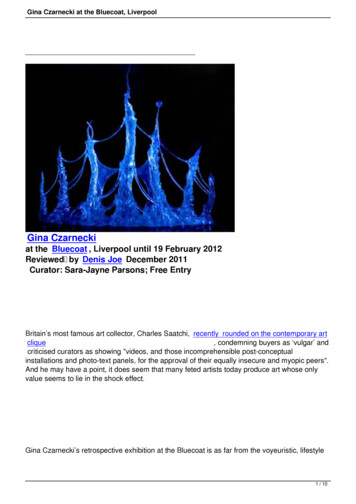
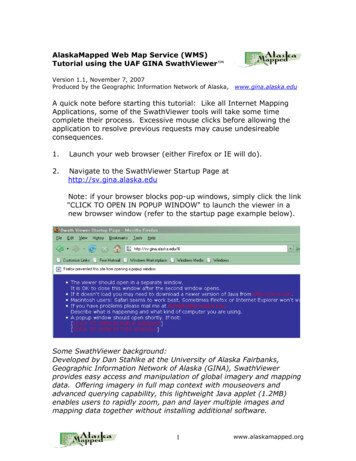
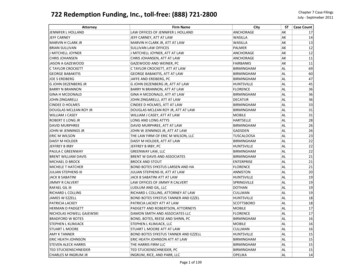


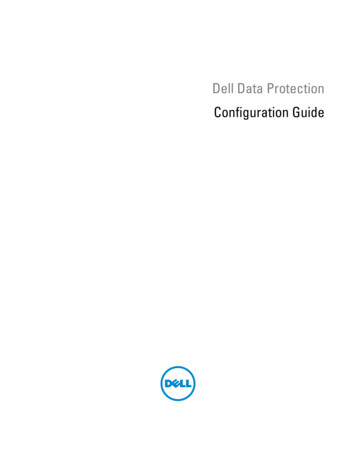

![Change Management Process For [Project Name] - West Virginia](/img/32/change-20management-20process-2003-2022-202012.jpg)
